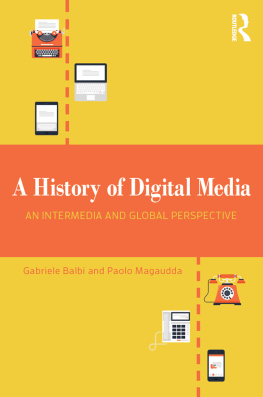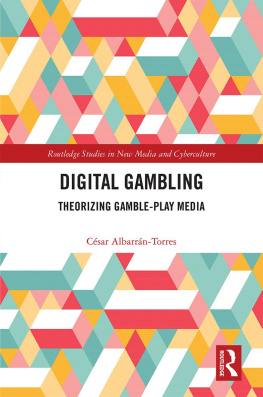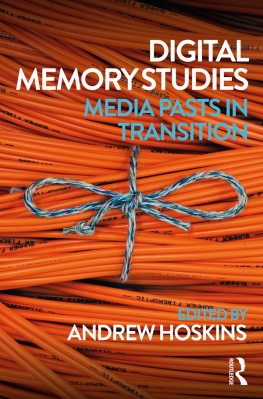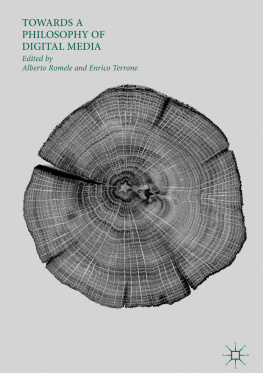Contents
Page List
Guide

A HISTORY OF DIGITAL MEDIA
From the punch card calculating machine to the personal computer to the iPhone and more, this in-depth text offers a comprehensive introduction to digital media history for students and scholars across media and communication studies, providing an overview of the main turning points in digital media and highlighting the interactions between political, business, technical, social, and cultural elements throughout history. With a global scope and an intermedia focus, this book enables students and scholars alike to deepen their critical understanding of digital communication, adding an understudied historical layer to the examination of digital media and societies. Discussion questions, a timeline, and previously unpublished tables and maps are included to guide readers as they learn to contextualize and critically analyze the digital technologies we use every day.
Gabriele Balbi is Assistant Professor in Media Studies at USI Universit della Svizzera Italiana (Switzerland), where he is Director of the China Media Observatory and teaches media history and sociology at the Faculty of Communication Sciences. His main areas of interest are media history and historiography of communication.
Paolo Magaudda is Senior Post-Doctoral Research Fellow in Sociology at the University of Padova (Italy), where his research is in technology, culture, and society with particular reference to media and consumption processes. Since 2013, he has been Secretary of STS Italia, the Italian Society for the Study of Science and Technology.
A HISTORY OF DIGITAL MEDIA
An Intermedia and Global Perspective
Gabriele Balbi and
Paolo Magaudda

First published 2018
by Routledge
711 Third Avenue, New York, NY 10017
and by Routledge
2 Park Square, Milton Park, Abingdon, Oxon OX14 4RN
Routledge is an imprint of the Taylor & Francis Group, an informa business
2018 Taylor & Francis
The right of Gabriele Balbi and Paolo Magaudda to be identified as the authors of this work has been asserted by them in accordance with sections 77 and 78 of the Copyright, Designs and Patents Act 1988.
All rights reserved. No part of this book may be reprinted or reproduced or utilised in any form or by any electronic, mechanical, or other means, now known or hereafter invented, including photocopying and recording, or in any information storage or retrieval system, without permission in writing from the publishers.
Trademark notice: Product or corporate names may be trademarks or registered trademarks, and are used only for identification and explanation without intent to infringe.
Library of Congress Cataloging in Publication Data
Names: Balbi, Gabriele, 1979- author. | Magaudda, Paolo, author.
Title: A history of digital media: an intermedia and global perspective /
Gabriele Balbi and Paolo Magaudda.
Other titles: Storia dei media digitali. English
Description: New York: Taylor & Francis Group, 2018. | Includes bibliographical references and index. | In several sections the text is an elaboration of the Italian book Storia dei media digitali. Rivoluzioni e continuit, published in 2014 by Laterza, Roma-Bari.Back of title page.
Identifiers: LCCN 2017050517| ISBN 9781138630215 (hardback) | ISBN 9781138630222 (pbk.)
Subjects: LCSH: Digital communicationsHistory. | Digital mediaHistory.
Classification: LCC TK5103.7 .B358413 2018 | DDC 384.3/309dc23
LC record available at https://lccn.loc.gov/2017050517
ISBN: 978-1-138-63021-5 (hbk)
ISBN: 978-1-138-63022-2 (pbk)
ISBN: 978-1-315-20963-0 (ebk)
Typeset in Interstate
by Florence Production Ltd, Stoodleigh, Devon, UK
Translated by Isabelle Johnson. Translation funded by Fondazione Hilda e Felice Vitali.
In several sections, the text is an elaboration of the Italian book Storia dei media digitali. Rivoluzioni e continuit, published in 2014 by Laterza, Roma-Bari. We acknowledge that Gabriele Balbi wrote , while the remaining sections have been written jointly.
CONTENTS
When we started to plan an English adaptation of our previous book, originally published in Italian in 2014 (Storia dei media digitali. Rivoluzioni e continuit, Roma-Bari, Laterza), we thought it would have been an easy task. The book we published in Italian, well-received in the Italian academic community and appeared in syllabi of several courses, would just require minor updates, we believed. As it commonly happens, things have been much more complicated and what we imagined as a translation turned out to be a substantial re-writing, with an entire new chapter and substantial changes in all the other chaptersnow all with learning materials, images, figures and especially much more global and intermedia than before. This work has not been done by the two authors in isolation, but many (new and old) ideas emerged during several discussions with friends and colleagues in many of the conferences and Italian book presentations we attended and were invited to between 2014 and 2017. Among the dozens of people that have directly or indirectly contributed to our work, we would like to thank a few colleagues specifically, while being well aware that we are going to forget many others: Raffaele Barberio, Luca Barra, Eleonora Benecchi, Tiziano Bonini, Paolo Bory, Davide Borrelli, Attila Bruni, Stefano Crabu, Alessandro Delfanti, Philip di Salvo, Andreas Fickers, Matthew Hibberd, Richard R. John, Juraj Kittler, Katharina Lobinger, Paolo Mancini, Alberto Marinelli, Massimo Mazzotti, Manuel Menke, Andrea Miconi, Sergio Minniti, Francesca Musiani, Simone Natale, Federico Neresini, Gianluigi Negro, Peppino Ortoleva, David Park, Benjamin Peters, John Durhman Peters, Benedetta Prario, Nelson Ribeiro, Giuseppe Richeri, Maria Rikitianskaia, Valrie Schafer, Christian Schwarzenegger, Daya Thussu, Assunta Viteritti and Guobin Yang. Massimo Scaglioni in Milan and Daniel Boccacci in Parma have provided logistical support in delicate phases of our work, when we were delivering the manuscript. Special gratitude goes to Isabelle Johnson, who has been in charge of the translation and was able to cope with all our requests and delays. Our thanks go also to our Italian publisher, Laterza, who allowed us to adapt the original Italian version for an English edition. We are also grateful to the team at Routledge and especially Erica Wetter, who helped us to sharpen our initial idea, and Mia Moran, who assisted us along the process.
Finding images is not easy for copyright issues and because they are not often considered relevant in academic works (we think exactly the opposite). So, we would like to thank all the people that made our image search easier: Beth Bernstein of RAND Corporations, Dave Walden, Nicholas Roche of NATO Archives, Pierre Philippi of Orange Archives, Timothy H. Horning of the Archives of University of Pennsylvania and Elisabeth Schares of Stiftung Deutsches TechnikmuseumBerlin. As mentioned, images are not always easy to get, so we decided to explore Instagram and search for private pictures, then asked permission from authors. Consequently, we thank Gary Hunt, Andy Leonard, Jack-Benny Persson, Matthew Ratzloff, and Marcin Wichary for allowing us to use their photos in the text (even though some of them didnt find place in the final version of the book). The Biblioteca universitaria di Lugano has assisted us particularly with the data appendix and we would like to thank especially Alessio Tutino; data are mainly taken from ITU Library and Archives Services, magnificently managed by Heather Heywood and Kristine Clara.








